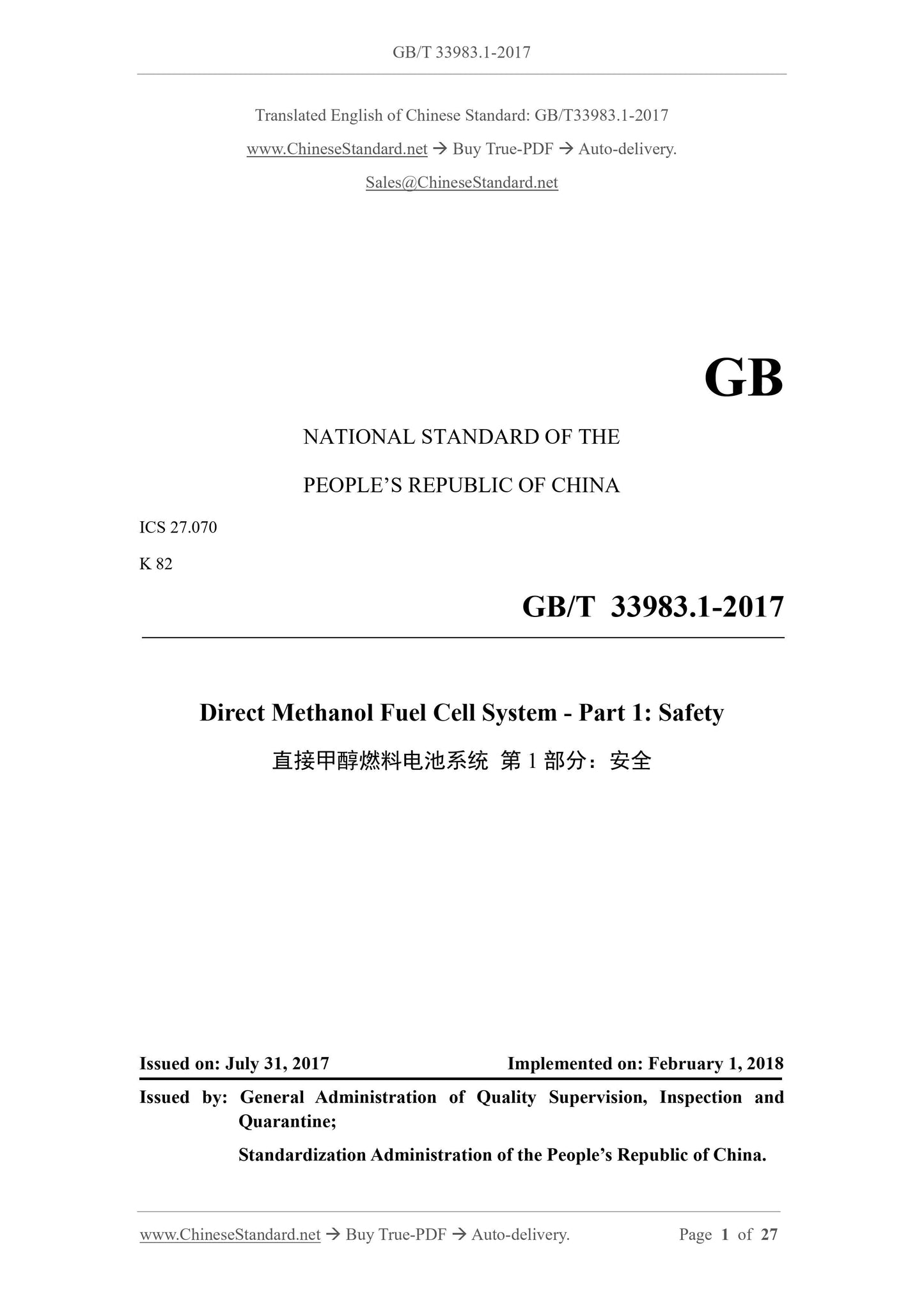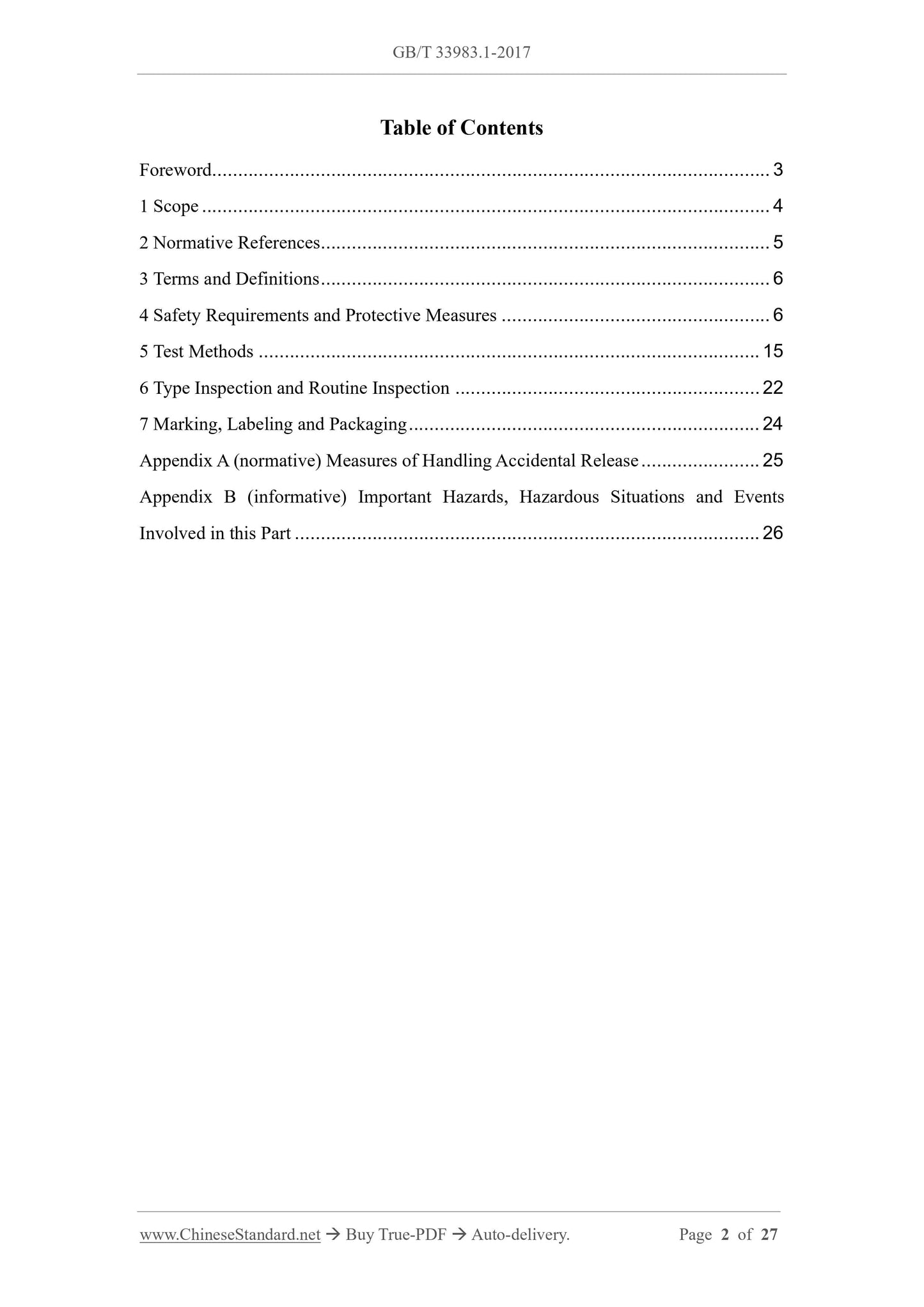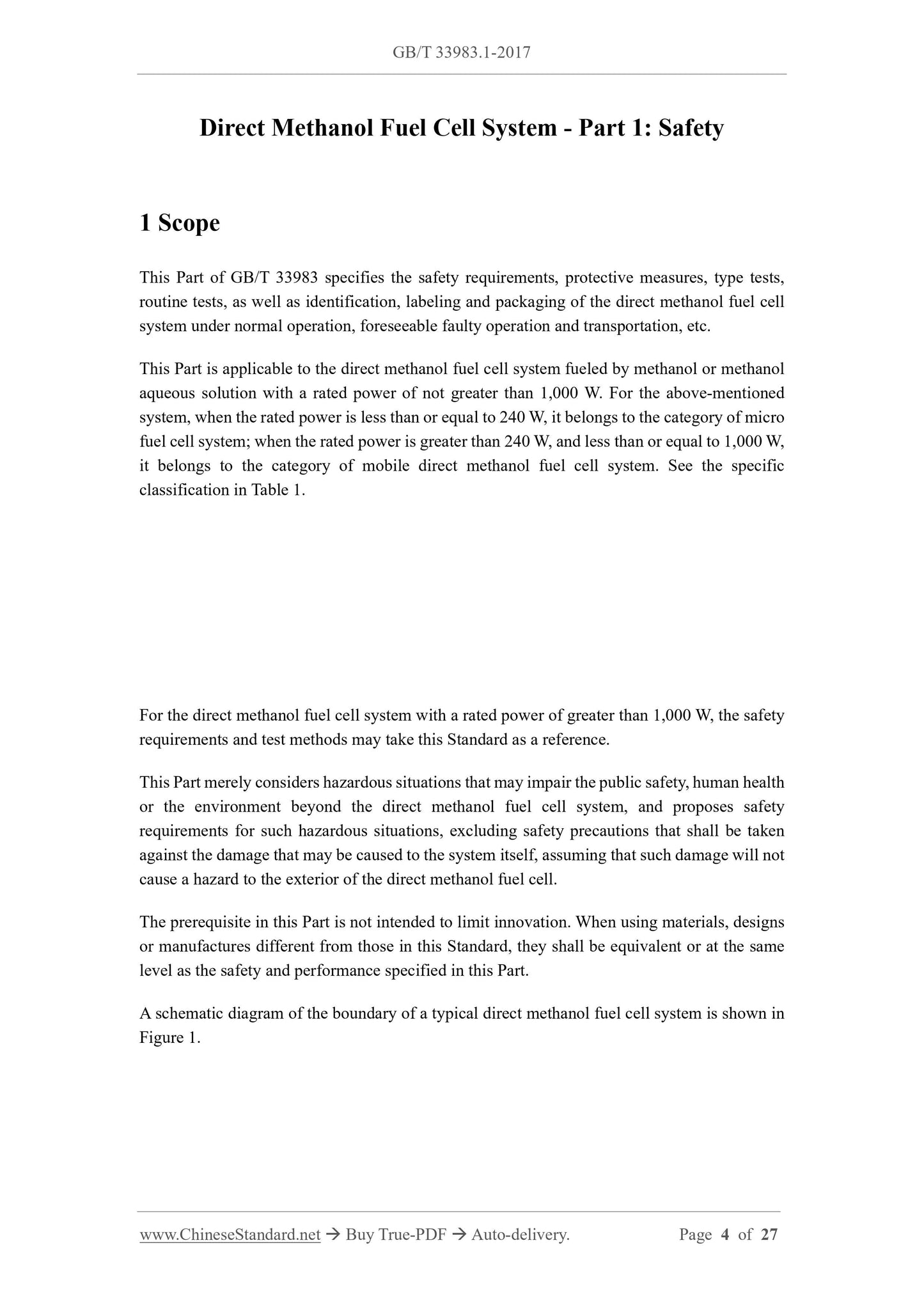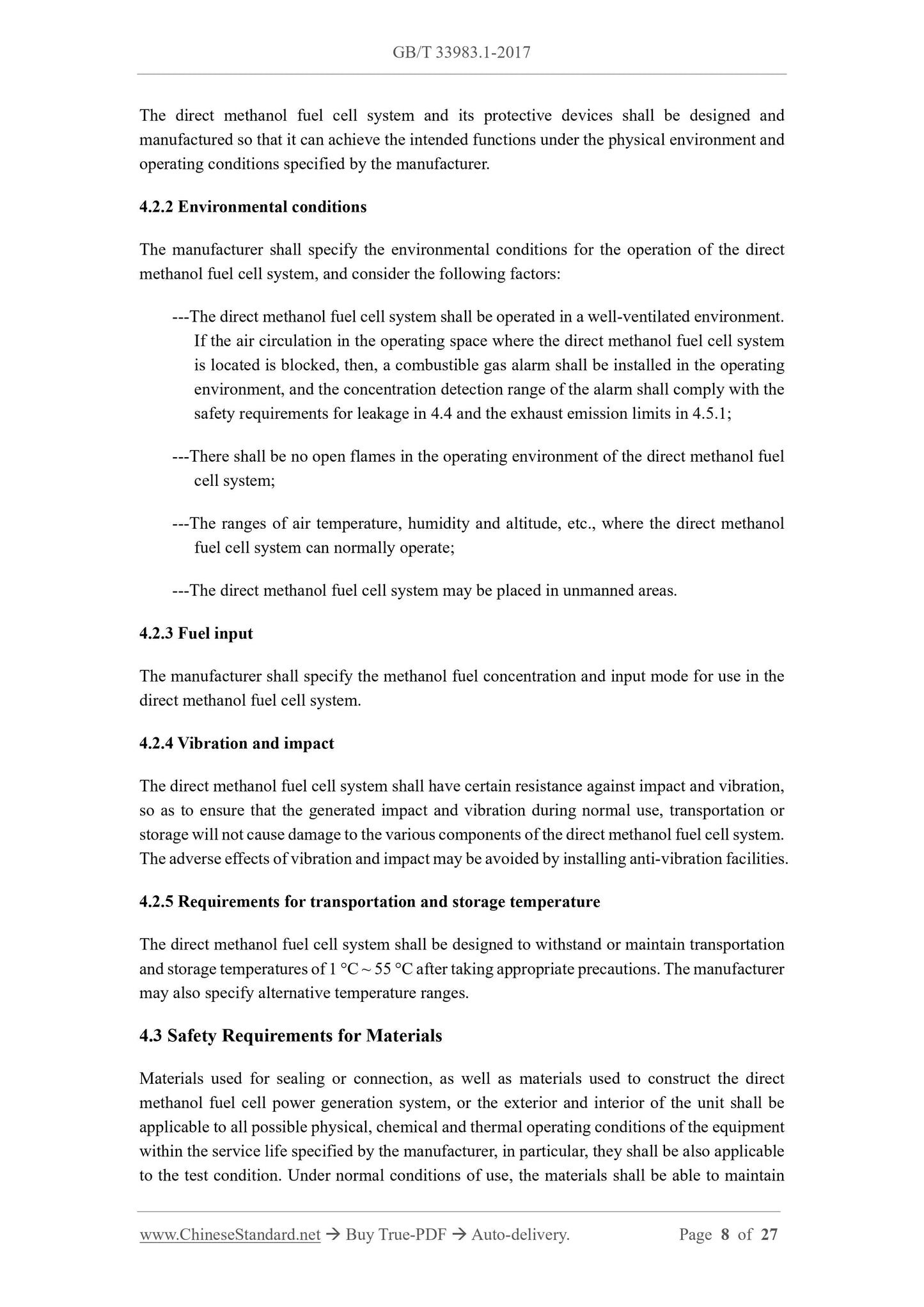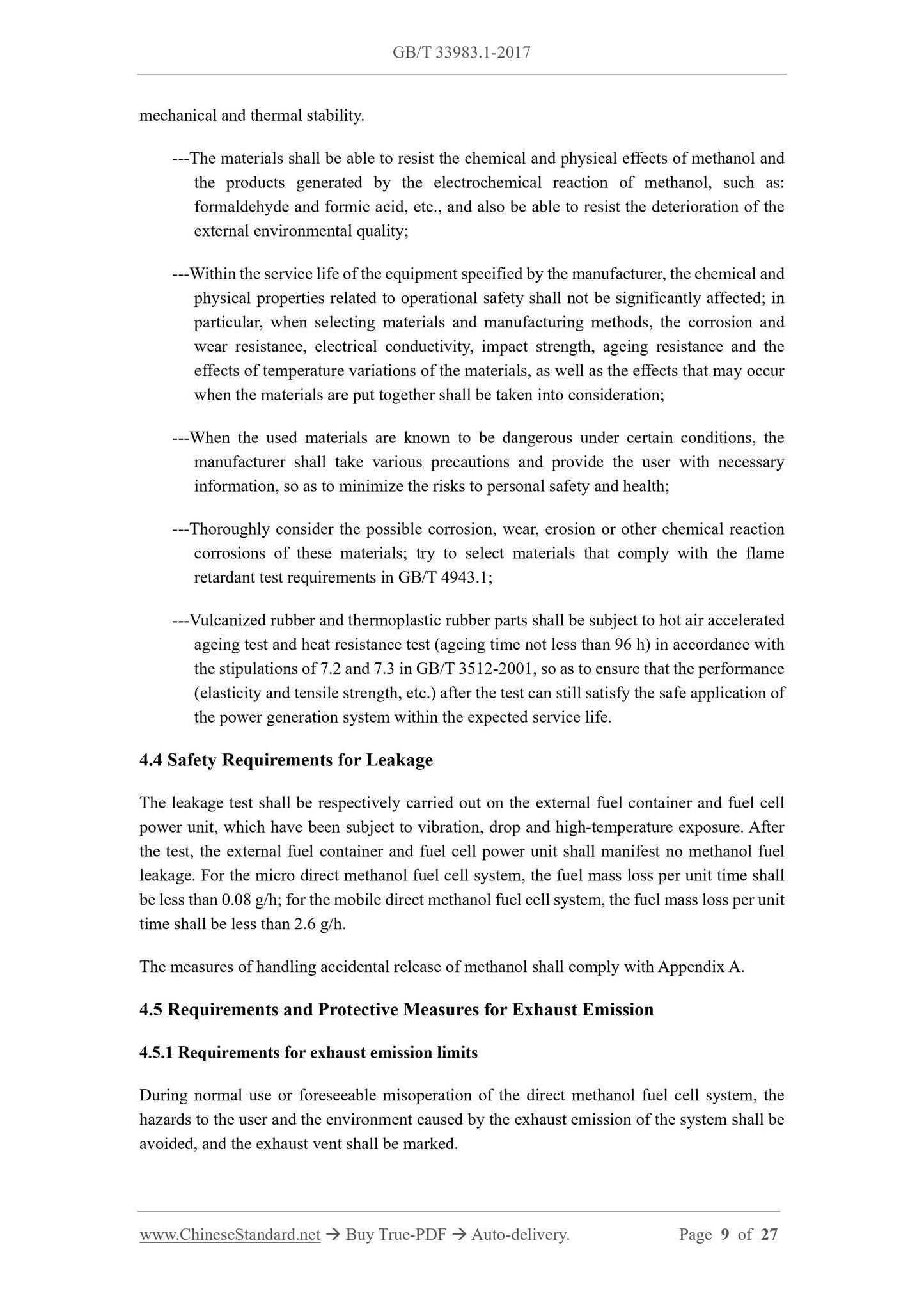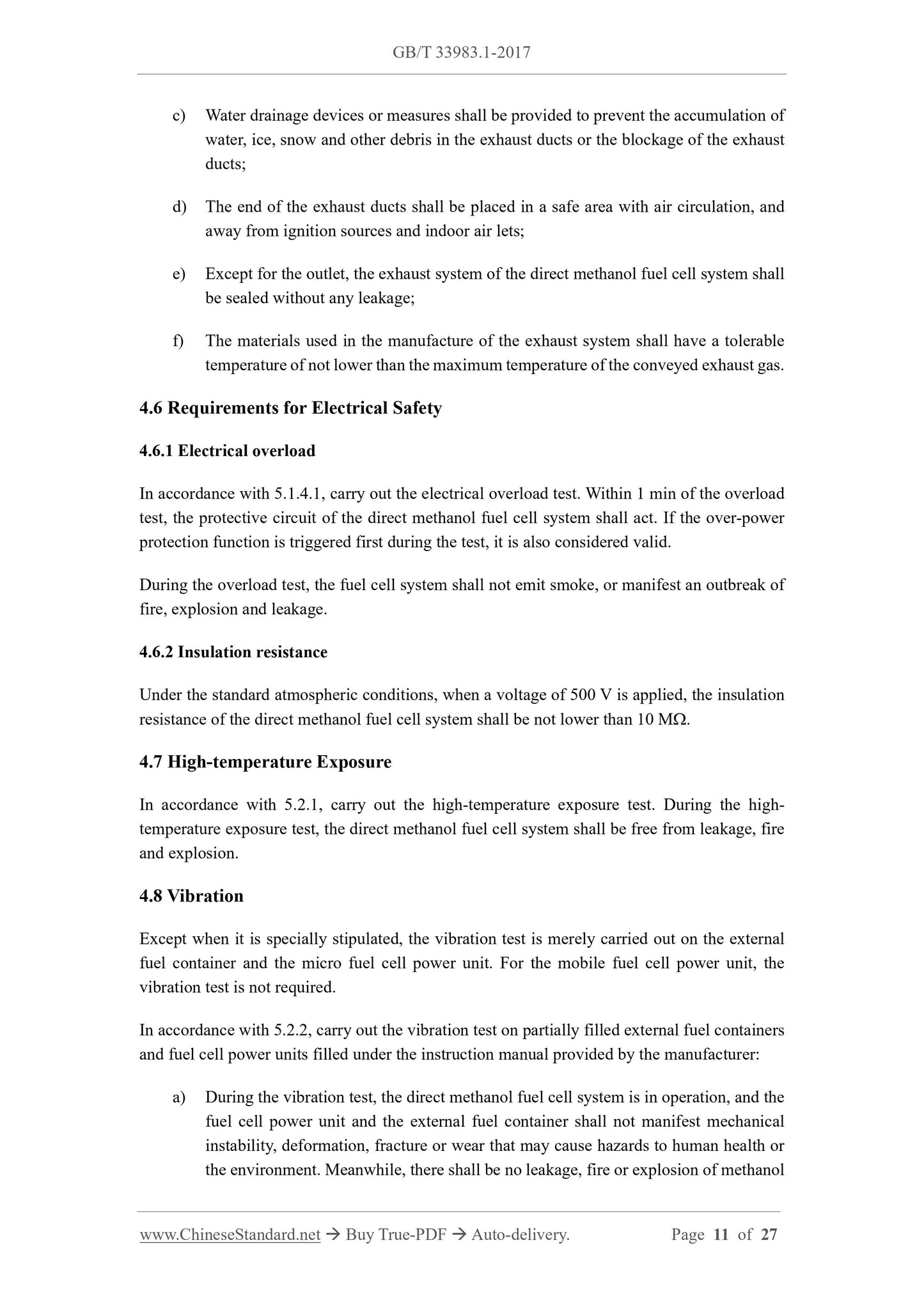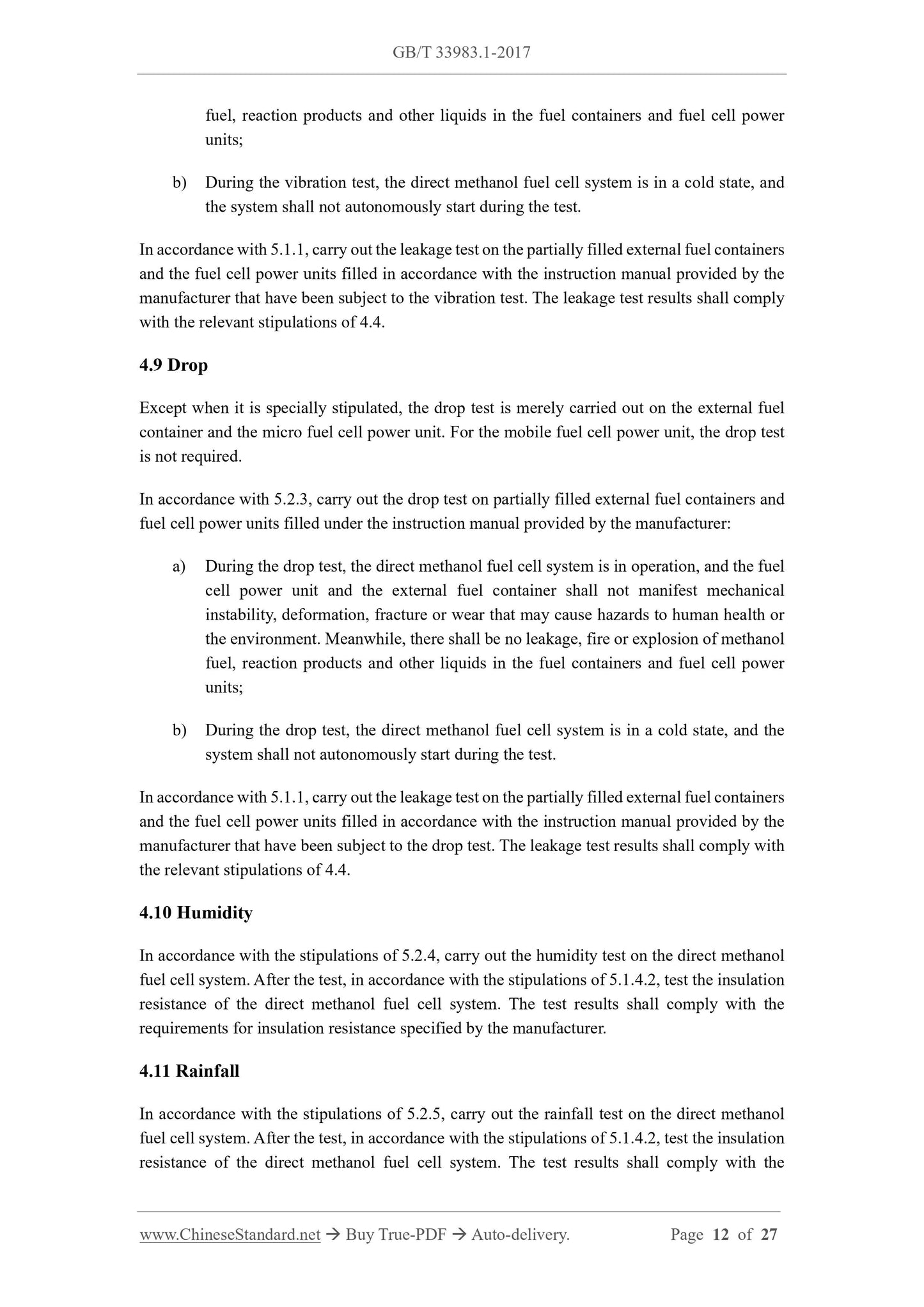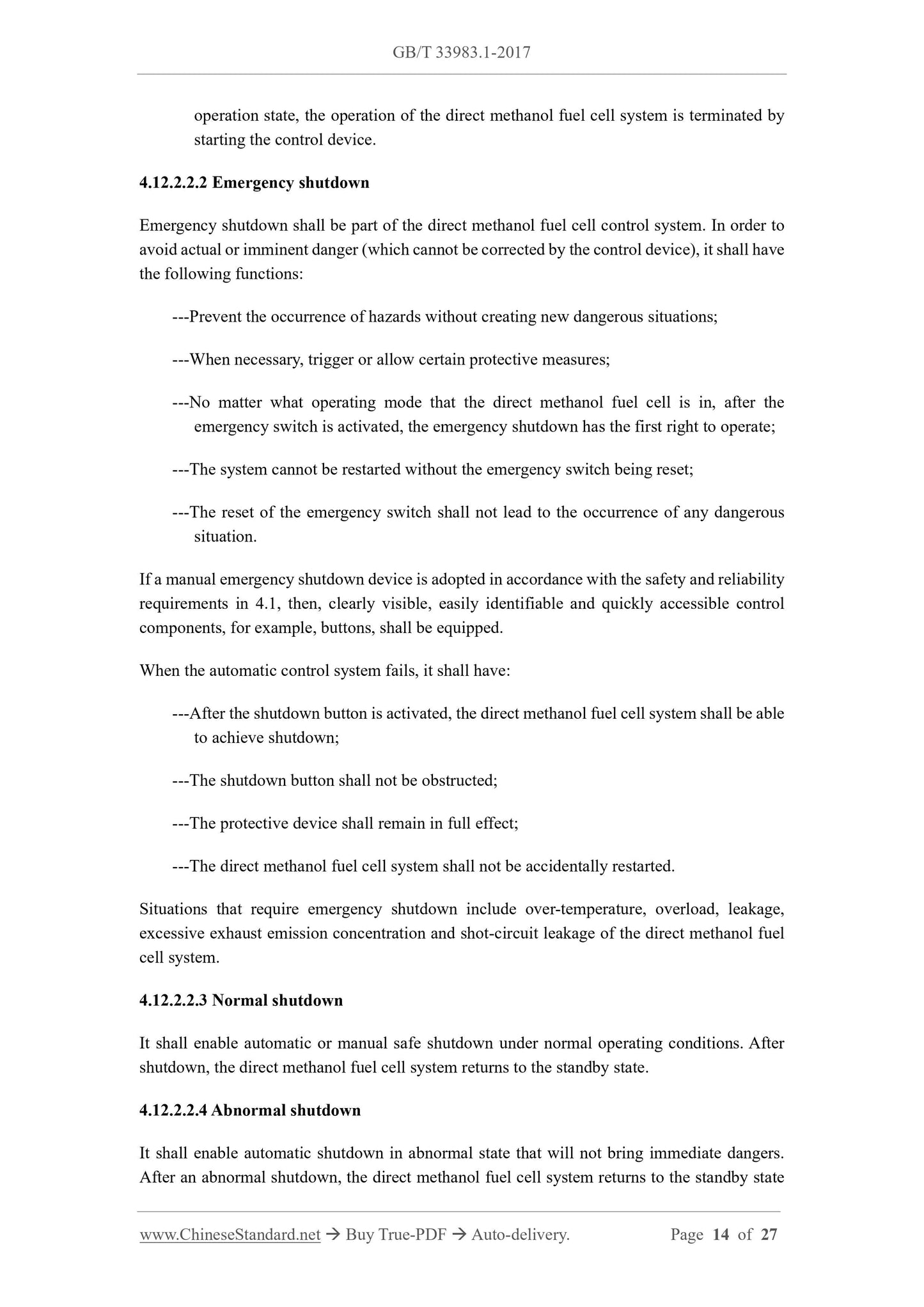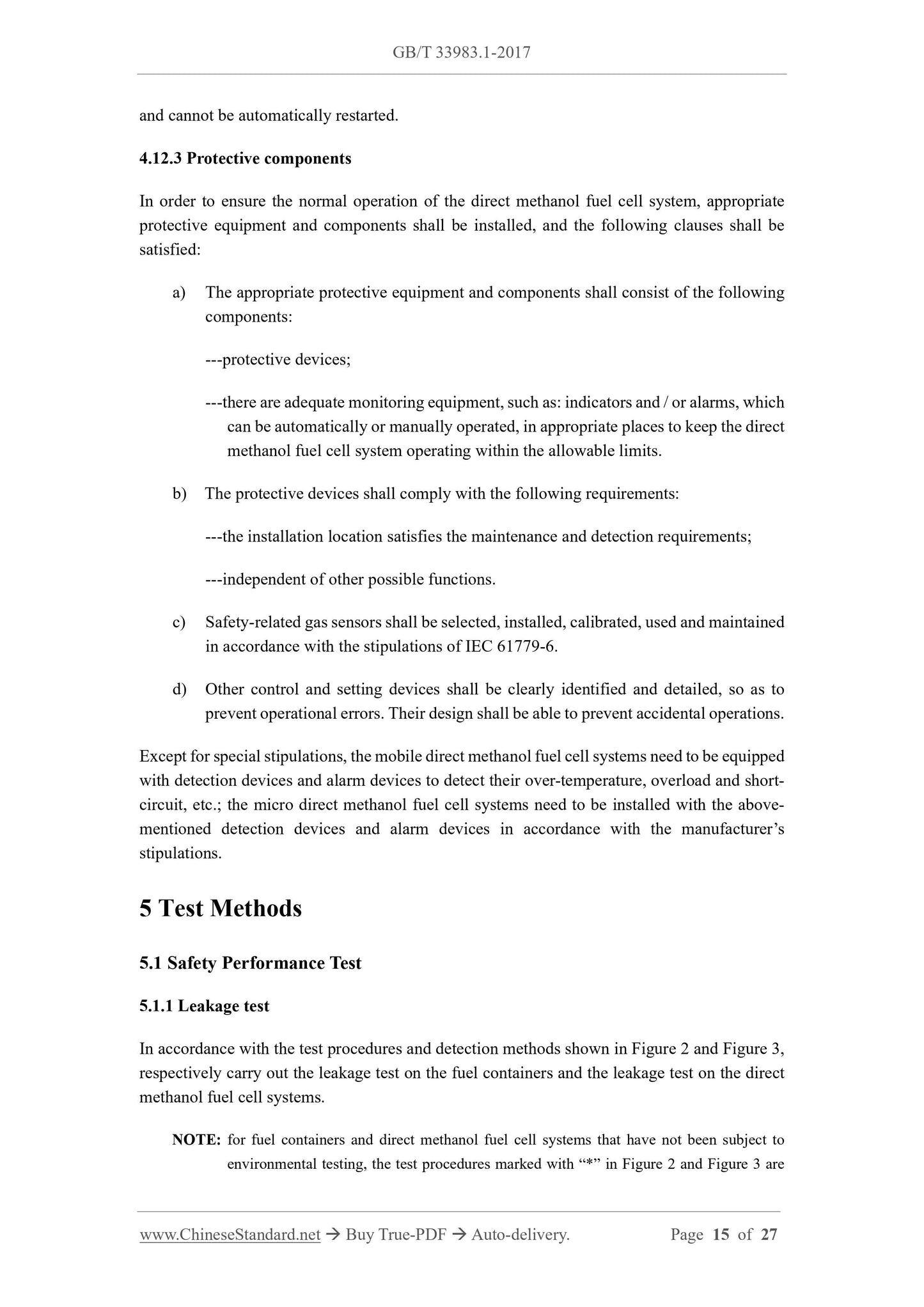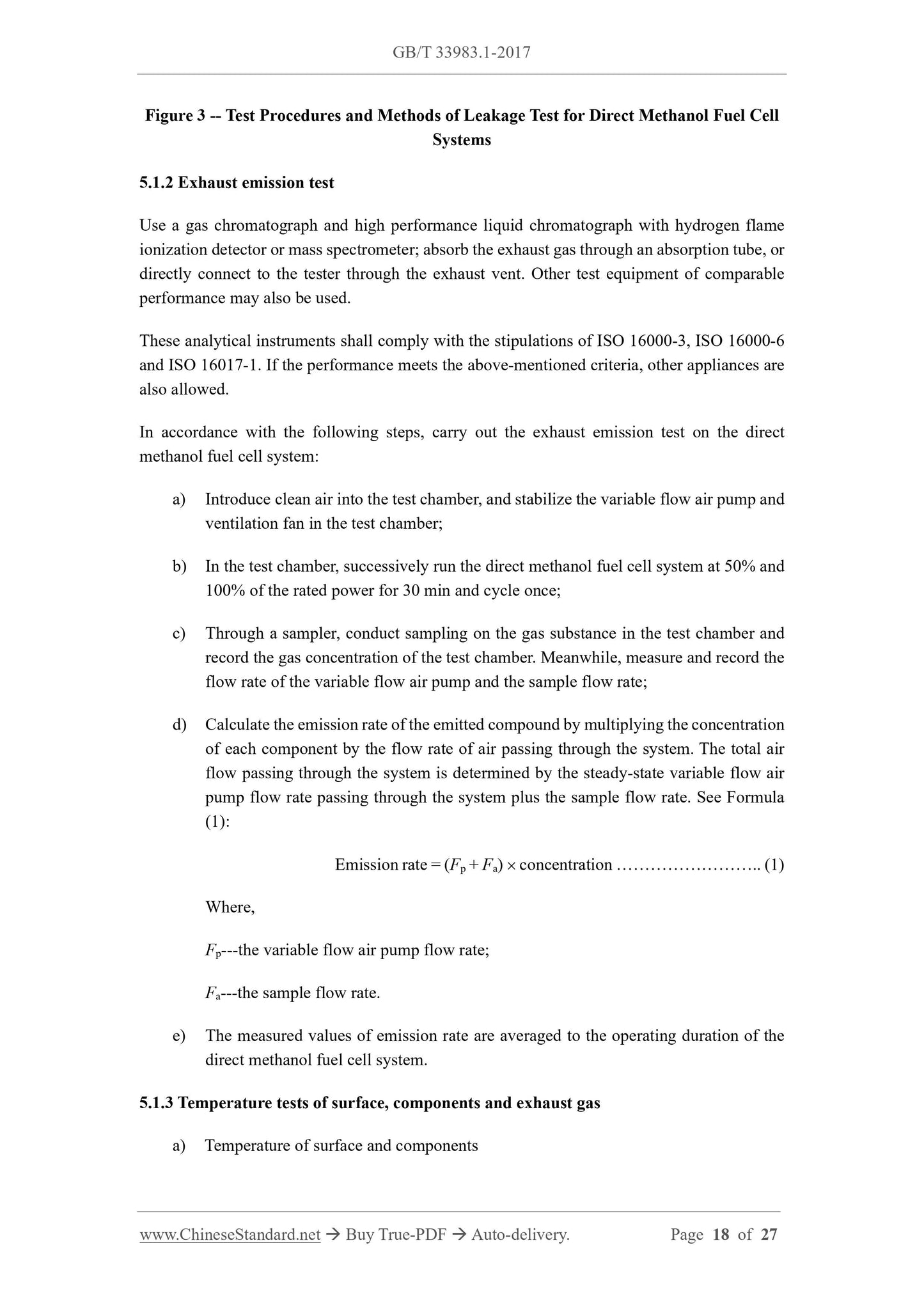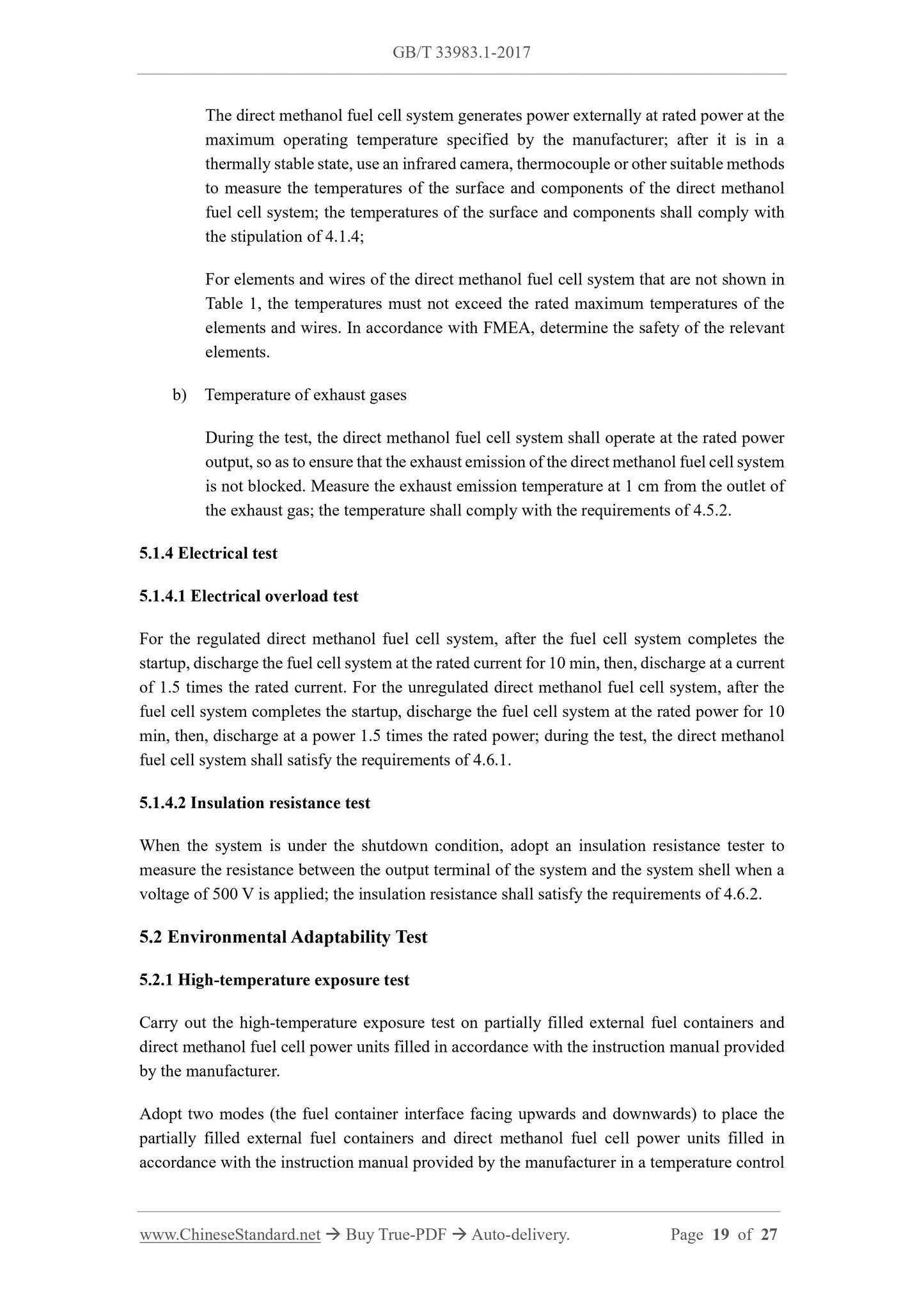1
/
of
11
www.ChineseStandard.us -- Field Test Asia Pte. Ltd.
GB/T 33983.1-2017 English PDF (GB/T33983.1-2017)
GB/T 33983.1-2017 English PDF (GB/T33983.1-2017)
Regular price
$290.00
Regular price
Sale price
$290.00
Unit price
/
per
Shipping calculated at checkout.
Couldn't load pickup availability
GB/T 33983.1-2017: Direct methanol fuel cell system - Part 1: Safety
Delivery: 9 seconds. Download (& Email) true-PDF + Invoice.
Get Quotation: Click GB/T 33983.1-2017 (Self-service in 1-minute)
Historical versions (Master-website): GB/T 33983.1-2017
Preview True-PDF (Reload/Scroll-down if blank)
GB/T 33983.1-2017
NATIONAL STANDARD OF THE
PEOPLE’S REPUBLIC OF CHINA
ICS 27.070
K 82
Direct Methanol Fuel Cell System - Part 1: Safety
ISSUED ON: JULY 31, 2017
IMPLEMENTED ON: FEBRUARY 1, 2018
Issued by: General Administration of Quality Supervision, Inspection and
Quarantine;
Standardization Administration of the People’s Republic of China.
Table of Contents
Foreword ... 3
1 Scope ... 4
2 Normative References... 5
3 Terms and Definitions ... 6
4 Safety Requirements and Protective Measures ... 6
5 Test Methods ... 15
6 Type Inspection and Routine Inspection ... 22
7 Marking, Labeling and Packaging ... 24
Appendix A (normative) Measures of Handling Accidental Release ... 25
Appendix B (informative) Important Hazards, Hazardous Situations and Events
Involved in this Part ... 26
Direct Methanol Fuel Cell System - Part 1: Safety
1 Scope
This Part of GB/T 33983 specifies the safety requirements, protective measures, type tests,
routine tests, as well as identification, labeling and packaging of the direct methanol fuel cell
system under normal operation, foreseeable faulty operation and transportation, etc.
This Part is applicable to the direct methanol fuel cell system fueled by methanol or methanol
aqueous solution with a rated power of not greater than 1,000 W. For the above-mentioned
system, when the rated power is less than or equal to 240 W, it belongs to the category of micro
fuel cell system; when the rated power is greater than 240 W, and less than or equal to 1,000 W,
it belongs to the category of mobile direct methanol fuel cell system. See the specific
classification in Table 1.
For the direct methanol fuel cell system with a rated power of greater than 1,000 W, the safety
requirements and test methods may take this Standard as a reference.
This Part merely considers hazardous situations that may impair the public safety, human health
or the environment beyond the direct methanol fuel cell system, and proposes safety
requirements for such hazardous situations, excluding safety precautions that shall be taken
against the damage that may be caused to the system itself, assuming that such damage will not
cause a hazard to the exterior of the direct methanol fuel cell.
The prerequisite in this Part is not intended to limit innovation. When using materials, designs
or manufactures different from those in this Standard, they shall be equivalent or at the same
level as the safety and performance specified in this Part.
A schematic diagram of the boundary of a typical direct methanol fuel cell system is shown in
Figure 1.
The direct methanol fuel cell system and its protective devices shall be designed and
manufactured so that it can achieve the intended functions under the physical environment and
operating conditions specified by the manufacturer.
4.2.2 Environmental conditions
The manufacturer shall specify the environmental conditions for the operation of the direct
methanol fuel cell system, and consider the following factors:
---The direct methanol fuel cell system shall be operated in a well-ventilated environment.
If the air circulation in the operating space where the direct methanol fuel cell system
is located is blocked, then, a combustible gas alarm shall be installed in the operating
environment, and the concentration detection range of the alarm shall comply with the
safety requirements for leakage in 4.4 and the exhaust emission limits in 4.5.1;
---There shall be no open flames in the operating environment of the direct methanol fuel
cell system;
---The ranges of air temperature, humidity and altitude, etc., where the direct methanol
fuel cell system can normally operate;
---The direct methanol fuel cell system may be placed in unmanned areas.
4.2.3 Fuel input
The manufacturer shall specify the methanol fuel concentration and input mode for use in the
direct methanol fuel cell system.
4.2.4 Vibration and impact
The direct methanol fuel cell system shall have certain resistance against impact and vibration,
so as to ensure that the generated impact and vibration during normal use, transportation or
storage will not cause damage to the various components of the direct methanol fuel cell system.
The adverse effects of vibration and impact may be avoided by installing anti-vibration facilities.
4.2.5 Requirements for transportation and storage temperature
The direct methanol fuel cell system shall be designed to withstand or maintain transportation
and storage temperatures of 1 C ~ 55 C after taking appropriate precautions. The manufacturer
may also specify alternative temperature ranges.
4.3 Safety Requirements for Materials
Materials used for sealing or connection, as well as materials used to construct the direct
methanol fuel cell power generation system, or the exterior and interior of the unit shall be
applicable to all possible physical, chemical and thermal operating conditions of the equipment
within the service life specified by the manufacturer, in particular, they shall be also applicable
to the test condition. Under normal conditions of use, the materials shall be able to maintain
mechanical and thermal stability.
---The materials shall be able to resist the chemical and physical effects of methanol and
the products generated by the electrochemical reaction of methanol, such as:
formaldehyde and formic acid, etc., and also be able to resist the deterioration of the
external environmental quality;
---Within the service life of the equipment specified by the manufacturer, the chemical and
physical properties related to operational safety shall not be significantly affected; in
particular, when selecting materials and manufacturing methods, the corrosion and
wear resistance, electrical conductivity, impact strength, ageing resistance and the
effects of temperature variations of the materials, as well as the effects that may occur
when the materials are put together shall be taken into consideration;
---When the used materials are known to be dangerous under certain conditions, the
manufacturer shall take various precautions and provide the user with necessary
information, so as to minimize the risks to personal safety and health;
---Thoroughly consider the possible corrosion, wear, erosion or other chemical reaction
corrosions of these materials; try to select materials that comply with the flame
retardant test requirements in GB/T 4943.1;
---Vulcanized rubber and thermoplastic rubber parts shall be subject to hot air accelerated
ageing test and heat resistance test (ageing time not less than 96 h) in accordance with
the stipulations of 7.2 and 7.3 in GB/T 3512-2001, so as to ensure that the performance
(elasticity and tensile strength, etc.) after the test can still satisfy the safe application of
the power generation system within the expected service life.
4.4 Safety Requirements for Leakage
The leakage test shall be respectively carried out on the external fuel container and fuel cell
power unit, which have been subject to vibration, drop and high-temperature exposure. After
the test, the external fuel container and fuel cell power unit shall manifest no methanol fuel
leakage. For the micro direct methanol fuel cell system, the fuel mass loss per unit time shall
be less than 0.08 g/h; for the mobile direct methanol fuel cell system, the fuel mass loss per unit
time shall be less than 2.6 g/h.
The measures of handling accidental release of methanol shall comply with Appendix A.
4.5 Requirements and Protective Measures for Exhaust Emission
4.5.1 Requirements for exhaust emission limits
During normal use or foreseeable misoperation of the direct methanol fuel cell system, the
hazards to the user and the environment caused by the exhaust emission of the system shall be
avoided, and the exhaust vent shall be marked.
c) Water drainage devices or measures shall be provided to prevent the accumulation of
water, ice, snow and other debris in the exhaust ducts or the blockage of the exhaust
ducts;
d) The end of the exhaust ducts shall be placed in a safe area with air circulation, and
away from ignition sources and indoor air lets;
e) Except for the outlet, the exhaust system of the direct methanol fuel cell system shall
be sealed without any leakage;
f) The materials used in the manufacture of the exhaust system shall have a tolerable
temperature of not lower than the maximum temperature of the conveyed exhaust gas.
4.6 Requirements for Electrical Safety
4.6.1 Electrical overload
In accordance with 5.1.4.1, carry out the electrical overload test. Within 1 min of the overload
test, the protective circuit of the direct methanol fuel cell system shall act. If the over-power
protection function is triggered first during the test, it is also considered valid.
During the overload test, the fuel cell system shall not emit smoke, or manifest an outbreak of
fire, explosion and leakage.
4.6.2 Insulation resistance
Under the standard atmospheric conditions, when a voltage of 500 V is applied, the insulation
resistance of the direct methanol fuel cell system shall be not lower than 10 M.
4.7 High-temperature Exposure
In accordance with 5.2.1, carry out the high-temperature exposure test. During the high-
temperature exposure test, the direct methanol fuel cell system shall be free from leakage, fire
and explosion.
4.8 Vibration
Except when it is specially stipulated, the vibration test is merely carried out on the external
fuel container and the micro fuel cell power unit. For the mobile fuel cell power unit, the
vibration test is not required.
In accordance with 5.2.2, carry out the vibration test on partially filled external fuel containers
and fuel cell power units filled under the instruction manual provided by the manufacturer:
a) During the vibration test, the direct methanol fuel cell system is in operation, and the
fuel cell power unit and the external fuel container shall not manifest mechanical
instability, deformation, fracture or wear that may cause hazards to human health or
the environment. Meanwhile, there shall be no leakage, fire or explosion of methanol
fuel, reaction products and other liquids in the fuel containers and fuel cell power
units;
b) During the vibration test, the direct methanol fuel cell system is in a cold state, and
the system shall not autonomously start during the test.
In accordance with 5.1.1, carry out the leakage test on the partially filled external fuel containers
and the fuel cell power units filled in accordance with the instruction manual provided by the
manufacturer that have been subject to the vibration test. The leakage test results shall comply
with the relevant stipulations of 4.4.
4.9 Drop
Except when it is specially stipulated, the drop test is merely carried out on the external fuel
container and the micro fuel cell power unit. For the mobile fuel cell power unit, the drop test
is not required.
In accordance with 5.2.3, carry out the drop test on partially filled external fuel containers and
fuel cell power units filled under the instruction manual provided by the manufacturer:
a) During the drop test, the direct methanol fuel cell system is in operation, and the fuel
cell power unit and the external fuel container shall not manifest mechanical
instability, deformation, fracture or wear that may cause hazards to human health or
the environment. Meanwhile, there shall be no leakage, fire or explosion of methanol
fuel, reaction products and other liquids in the fuel containers and fuel cell power
units;
b) During the drop test, the direct methanol fuel cell system is in a cold state, and the
system shall not autonomously start during the test.
In accordance with 5.1.1, carry out the leakage test on the partially filled external fuel containers
and the fuel cell power units filled in accordance with the instruction manual provided by the
manufacturer that have been subject to the drop test. The leakage test results shall comply with
the relevant stipulations of 4.4.
4.10 Humidity
In accordance with the stipulations of 5.2.4, carry out the humidity test on the direct methanol
fuel cell system. After the test, in accordance with the stipulations of 5.1.4.2, test the insulation
resistance of the direct methanol fuel cell system. The test results shall comply with the
requirements for insulation resistance specified by the manufacturer.
4.11 Rainfall
In accordance with the stipulations of 5.2.5, carry out the rainfall test on the direct methanol
fuel cell system. After the test, in accordance with the stipulations of 5.1.4.2, test the insulation
resistance of the direct methanol fuel cell system. The test results shall comply with the
operation state, the operation of the direct methanol fuel cell system is terminated by
starting the control device.
4.12.2.2.2 Emergency shutdown
Emergency shutdown shall be part of the direct methanol fuel cell control system. In order to
avoid actual or imminent danger (which cannot be corrected by the control device), it shall have
the following functions:
---Prevent the occurrence of hazards without creating new dangerous situations;
---When necessary, trigger or allow certain protective measures;
---No matter what operating mode that the direct methanol fuel cell is in, after the
emergency switch is activated, the emergency shutdown has the first right to operate;
---The system cannot be restarted without the emergency switch being reset;
---The reset of the emergency switch shall not lead to the occurrence of any dangerous
situation.
If a manual emergency shutdown device is adopted in accordance with the safety and reliability
requirements in 4.1, then, clearly visible, easily identifiable and quickly accessible control
components, for example, buttons, shall be equipped.
When the automatic control system fails, it shall have:
---After the shutdown button is activated, the direct methanol fuel cell system shall be able
to achieve shutdown;
---The shutdown button shall not be obstructed;
---The protective device sha...
Delivery: 9 seconds. Download (& Email) true-PDF + Invoice.
Get Quotation: Click GB/T 33983.1-2017 (Self-service in 1-minute)
Historical versions (Master-website): GB/T 33983.1-2017
Preview True-PDF (Reload/Scroll-down if blank)
GB/T 33983.1-2017
NATIONAL STANDARD OF THE
PEOPLE’S REPUBLIC OF CHINA
ICS 27.070
K 82
Direct Methanol Fuel Cell System - Part 1: Safety
ISSUED ON: JULY 31, 2017
IMPLEMENTED ON: FEBRUARY 1, 2018
Issued by: General Administration of Quality Supervision, Inspection and
Quarantine;
Standardization Administration of the People’s Republic of China.
Table of Contents
Foreword ... 3
1 Scope ... 4
2 Normative References... 5
3 Terms and Definitions ... 6
4 Safety Requirements and Protective Measures ... 6
5 Test Methods ... 15
6 Type Inspection and Routine Inspection ... 22
7 Marking, Labeling and Packaging ... 24
Appendix A (normative) Measures of Handling Accidental Release ... 25
Appendix B (informative) Important Hazards, Hazardous Situations and Events
Involved in this Part ... 26
Direct Methanol Fuel Cell System - Part 1: Safety
1 Scope
This Part of GB/T 33983 specifies the safety requirements, protective measures, type tests,
routine tests, as well as identification, labeling and packaging of the direct methanol fuel cell
system under normal operation, foreseeable faulty operation and transportation, etc.
This Part is applicable to the direct methanol fuel cell system fueled by methanol or methanol
aqueous solution with a rated power of not greater than 1,000 W. For the above-mentioned
system, when the rated power is less than or equal to 240 W, it belongs to the category of micro
fuel cell system; when the rated power is greater than 240 W, and less than or equal to 1,000 W,
it belongs to the category of mobile direct methanol fuel cell system. See the specific
classification in Table 1.
For the direct methanol fuel cell system with a rated power of greater than 1,000 W, the safety
requirements and test methods may take this Standard as a reference.
This Part merely considers hazardous situations that may impair the public safety, human health
or the environment beyond the direct methanol fuel cell system, and proposes safety
requirements for such hazardous situations, excluding safety precautions that shall be taken
against the damage that may be caused to the system itself, assuming that such damage will not
cause a hazard to the exterior of the direct methanol fuel cell.
The prerequisite in this Part is not intended to limit innovation. When using materials, designs
or manufactures different from those in this Standard, they shall be equivalent or at the same
level as the safety and performance specified in this Part.
A schematic diagram of the boundary of a typical direct methanol fuel cell system is shown in
Figure 1.
The direct methanol fuel cell system and its protective devices shall be designed and
manufactured so that it can achieve the intended functions under the physical environment and
operating conditions specified by the manufacturer.
4.2.2 Environmental conditions
The manufacturer shall specify the environmental conditions for the operation of the direct
methanol fuel cell system, and consider the following factors:
---The direct methanol fuel cell system shall be operated in a well-ventilated environment.
If the air circulation in the operating space where the direct methanol fuel cell system
is located is blocked, then, a combustible gas alarm shall be installed in the operating
environment, and the concentration detection range of the alarm shall comply with the
safety requirements for leakage in 4.4 and the exhaust emission limits in 4.5.1;
---There shall be no open flames in the operating environment of the direct methanol fuel
cell system;
---The ranges of air temperature, humidity and altitude, etc., where the direct methanol
fuel cell system can normally operate;
---The direct methanol fuel cell system may be placed in unmanned areas.
4.2.3 Fuel input
The manufacturer shall specify the methanol fuel concentration and input mode for use in the
direct methanol fuel cell system.
4.2.4 Vibration and impact
The direct methanol fuel cell system shall have certain resistance against impact and vibration,
so as to ensure that the generated impact and vibration during normal use, transportation or
storage will not cause damage to the various components of the direct methanol fuel cell system.
The adverse effects of vibration and impact may be avoided by installing anti-vibration facilities.
4.2.5 Requirements for transportation and storage temperature
The direct methanol fuel cell system shall be designed to withstand or maintain transportation
and storage temperatures of 1 C ~ 55 C after taking appropriate precautions. The manufacturer
may also specify alternative temperature ranges.
4.3 Safety Requirements for Materials
Materials used for sealing or connection, as well as materials used to construct the direct
methanol fuel cell power generation system, or the exterior and interior of the unit shall be
applicable to all possible physical, chemical and thermal operating conditions of the equipment
within the service life specified by the manufacturer, in particular, they shall be also applicable
to the test condition. Under normal conditions of use, the materials shall be able to maintain
mechanical and thermal stability.
---The materials shall be able to resist the chemical and physical effects of methanol and
the products generated by the electrochemical reaction of methanol, such as:
formaldehyde and formic acid, etc., and also be able to resist the deterioration of the
external environmental quality;
---Within the service life of the equipment specified by the manufacturer, the chemical and
physical properties related to operational safety shall not be significantly affected; in
particular, when selecting materials and manufacturing methods, the corrosion and
wear resistance, electrical conductivity, impact strength, ageing resistance and the
effects of temperature variations of the materials, as well as the effects that may occur
when the materials are put together shall be taken into consideration;
---When the used materials are known to be dangerous under certain conditions, the
manufacturer shall take various precautions and provide the user with necessary
information, so as to minimize the risks to personal safety and health;
---Thoroughly consider the possible corrosion, wear, erosion or other chemical reaction
corrosions of these materials; try to select materials that comply with the flame
retardant test requirements in GB/T 4943.1;
---Vulcanized rubber and thermoplastic rubber parts shall be subject to hot air accelerated
ageing test and heat resistance test (ageing time not less than 96 h) in accordance with
the stipulations of 7.2 and 7.3 in GB/T 3512-2001, so as to ensure that the performance
(elasticity and tensile strength, etc.) after the test can still satisfy the safe application of
the power generation system within the expected service life.
4.4 Safety Requirements for Leakage
The leakage test shall be respectively carried out on the external fuel container and fuel cell
power unit, which have been subject to vibration, drop and high-temperature exposure. After
the test, the external fuel container and fuel cell power unit shall manifest no methanol fuel
leakage. For the micro direct methanol fuel cell system, the fuel mass loss per unit time shall
be less than 0.08 g/h; for the mobile direct methanol fuel cell system, the fuel mass loss per unit
time shall be less than 2.6 g/h.
The measures of handling accidental release of methanol shall comply with Appendix A.
4.5 Requirements and Protective Measures for Exhaust Emission
4.5.1 Requirements for exhaust emission limits
During normal use or foreseeable misoperation of the direct methanol fuel cell system, the
hazards to the user and the environment caused by the exhaust emission of the system shall be
avoided, and the exhaust vent shall be marked.
c) Water drainage devices or measures shall be provided to prevent the accumulation of
water, ice, snow and other debris in the exhaust ducts or the blockage of the exhaust
ducts;
d) The end of the exhaust ducts shall be placed in a safe area with air circulation, and
away from ignition sources and indoor air lets;
e) Except for the outlet, the exhaust system of the direct methanol fuel cell system shall
be sealed without any leakage;
f) The materials used in the manufacture of the exhaust system shall have a tolerable
temperature of not lower than the maximum temperature of the conveyed exhaust gas.
4.6 Requirements for Electrical Safety
4.6.1 Electrical overload
In accordance with 5.1.4.1, carry out the electrical overload test. Within 1 min of the overload
test, the protective circuit of the direct methanol fuel cell system shall act. If the over-power
protection function is triggered first during the test, it is also considered valid.
During the overload test, the fuel cell system shall not emit smoke, or manifest an outbreak of
fire, explosion and leakage.
4.6.2 Insulation resistance
Under the standard atmospheric conditions, when a voltage of 500 V is applied, the insulation
resistance of the direct methanol fuel cell system shall be not lower than 10 M.
4.7 High-temperature Exposure
In accordance with 5.2.1, carry out the high-temperature exposure test. During the high-
temperature exposure test, the direct methanol fuel cell system shall be free from leakage, fire
and explosion.
4.8 Vibration
Except when it is specially stipulated, the vibration test is merely carried out on the external
fuel container and the micro fuel cell power unit. For the mobile fuel cell power unit, the
vibration test is not required.
In accordance with 5.2.2, carry out the vibration test on partially filled external fuel containers
and fuel cell power units filled under the instruction manual provided by the manufacturer:
a) During the vibration test, the direct methanol fuel cell system is in operation, and the
fuel cell power unit and the external fuel container shall not manifest mechanical
instability, deformation, fracture or wear that may cause hazards to human health or
the environment. Meanwhile, there shall be no leakage, fire or explosion of methanol
fuel, reaction products and other liquids in the fuel containers and fuel cell power
units;
b) During the vibration test, the direct methanol fuel cell system is in a cold state, and
the system shall not autonomously start during the test.
In accordance with 5.1.1, carry out the leakage test on the partially filled external fuel containers
and the fuel cell power units filled in accordance with the instruction manual provided by the
manufacturer that have been subject to the vibration test. The leakage test results shall comply
with the relevant stipulations of 4.4.
4.9 Drop
Except when it is specially stipulated, the drop test is merely carried out on the external fuel
container and the micro fuel cell power unit. For the mobile fuel cell power unit, the drop test
is not required.
In accordance with 5.2.3, carry out the drop test on partially filled external fuel containers and
fuel cell power units filled under the instruction manual provided by the manufacturer:
a) During the drop test, the direct methanol fuel cell system is in operation, and the fuel
cell power unit and the external fuel container shall not manifest mechanical
instability, deformation, fracture or wear that may cause hazards to human health or
the environment. Meanwhile, there shall be no leakage, fire or explosion of methanol
fuel, reaction products and other liquids in the fuel containers and fuel cell power
units;
b) During the drop test, the direct methanol fuel cell system is in a cold state, and the
system shall not autonomously start during the test.
In accordance with 5.1.1, carry out the leakage test on the partially filled external fuel containers
and the fuel cell power units filled in accordance with the instruction manual provided by the
manufacturer that have been subject to the drop test. The leakage test results shall comply with
the relevant stipulations of 4.4.
4.10 Humidity
In accordance with the stipulations of 5.2.4, carry out the humidity test on the direct methanol
fuel cell system. After the test, in accordance with the stipulations of 5.1.4.2, test the insulation
resistance of the direct methanol fuel cell system. The test results shall comply with the
requirements for insulation resistance specified by the manufacturer.
4.11 Rainfall
In accordance with the stipulations of 5.2.5, carry out the rainfall test on the direct methanol
fuel cell system. After the test, in accordance with the stipulations of 5.1.4.2, test the insulation
resistance of the direct methanol fuel cell system. The test results shall comply with the
operation state, the operation of the direct methanol fuel cell system is terminated by
starting the control device.
4.12.2.2.2 Emergency shutdown
Emergency shutdown shall be part of the direct methanol fuel cell control system. In order to
avoid actual or imminent danger (which cannot be corrected by the control device), it shall have
the following functions:
---Prevent the occurrence of hazards without creating new dangerous situations;
---When necessary, trigger or allow certain protective measures;
---No matter what operating mode that the direct methanol fuel cell is in, after the
emergency switch is activated, the emergency shutdown has the first right to operate;
---The system cannot be restarted without the emergency switch being reset;
---The reset of the emergency switch shall not lead to the occurrence of any dangerous
situation.
If a manual emergency shutdown device is adopted in accordance with the safety and reliability
requirements in 4.1, then, clearly visible, easily identifiable and quickly accessible control
components, for example, buttons, shall be equipped.
When the automatic control system fails, it shall have:
---After the shutdown button is activated, the direct methanol fuel cell system shall be able
to achieve shutdown;
---The shutdown button shall not be obstructed;
---The protective device sha...
Share
